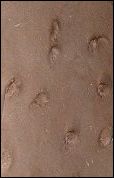

You've all heard of biology, geology, and a whole host of other 'ologies'. But have you run into ichnology? Don't worry about it if you haven't—it's not really a subject bandied about at cocktail parties or PTA meetings. It's the rather esoteric field that studies traces of organisms in the fossil record. Go out into the desert, and you'll see all sorts of disturbances of the ground surface. Over here, perhaps the dimples in sand made by a beetle; over there, the paw prints and tail draggings of a kangaroo rat. Bury these and turn the ground to rock, and you have the raw materials for the study of ichnology.
A trained ichnologist, examining ancient marine rocks, has no trouble
telling the trail of a trilobite from that of a snail, or the fossil burrow of a marine
worm from that of a clam. It's not only the little stuff that's raw material
for their studies, though. Dinosaur tracks tell all sorts of tales—from size to
stride to herding instinct. All grist for your next PTA meeting!

Contributor: Arthur H. Harris, Laboratory for Environmental Biology, Centennial Museum, University of Texas at El Paso.
Desert Diary is a joint production of the Centennial Museum and KTEP National Public Radio at the University of Texas at El Paso.

Footprints of a small, Jurassic dinosaur, Ornitholestes. Centennial Museum specimen.
Bromley, R. G. 1990. Trace fossils, biology and taphonomy: Special Topics in Palaeontology 3: London, Unwin Hyman, 280 pp.
HAUBOLD, H., and G. KATZUNG. 1978. Palaeoecology and
palaeoenvironments of tetrapod footprints. Palaeogeography, Palaeoclimatology,
Palaeoecology, 23:307-323. ![]()